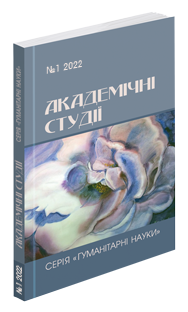Abstract
The paper is dedicated to the study of verbal aggression in the Ukrainian-speaking segment of the social media discourse. The goal of the study was to identify the functions of zoosemisms (animal names used figuratively) used in the aggressive verbal behavior of users of the social media Facebook, which included the solution of the following tasks: tracing the development of the conflict interactions of users of the given social media, highlighting the lexical markers of verbal aggression, and analyzing the functions of zoosemisms in situations of expressing doubts about the intelligence of the object of aggression. The source base was the Ukrainian-speaking segment of the social media Facebook, and the actual material includes more than 200 comments selected by the method of continuous sampling. All the comments meet two criteria: aggressive content and a zoosemism present. The conflict interactions of users of the social media Facebook were analyzed, and among the productive communicative tactics, the tactic of insulting the object of aggression was discovered, especially if expressing doubts about their intelligence, the tactic of making things personal and the tactic of provocative questions. It was recorded that by using these tactics, the intention of the speaker is to demonstrate their own intelligence and emphasize the opposition ‘friend or foe’. It was found that in the presence of the aggressive connotation of the comment, the polite ‘You’ nomination doesn’t indicate author’s respect for the interlocutor and doesn’t mitigate the destructive content of the statement. Both the interlocutor and a person (or an object) not involved in the communicative act can be objects of aggression. It was found that zoosemisms are a manifestation of linguistic creativity of the speakers; they mark implicit aggression, are used instead of profanity, and in comparisons instead of direct insults.
References
Войцехівська Н. К. Конфліктний дискурс: структурно-семантичний і комунікативно-прагматичний аспекти : монографія. Київ : Видавничий дім Дмитра Бураго, 2018. 404 с.
Кондратенко Н. В. Вербальна агресія у спілкуванні в соціальних мережах: актуалізація етнічних гетеро- стереотипів. Записки з українського мовознавства. 2019. № 2(26). С. 227–233. https://doi.org/10.18524/2414-062 7.2019.26.181746
Кривенко Г. Л. Зоосемізми в англійській та українській мовах: семантико-когнітивний і функціонально- прагматичний аспекти : автореф. дис. ... канд. філол. наук : 10.02.17. Київ, 2006. 24 с. URL: https://goo.su/aDAv
Курбанов И. А. Анализ зоосимволики в русском и английском языках : автореф. дисс. ... канд. филол. наук : 10.02.19. Москва, 2000. URL: https://goo.su/a7gb
Ніколашина Т. Зооморфізми в жарґонно-сленговій комунікації. Eslavística Complutense. 2008. № 8. С. 125–133. URL: https://goo.su/9Cti

